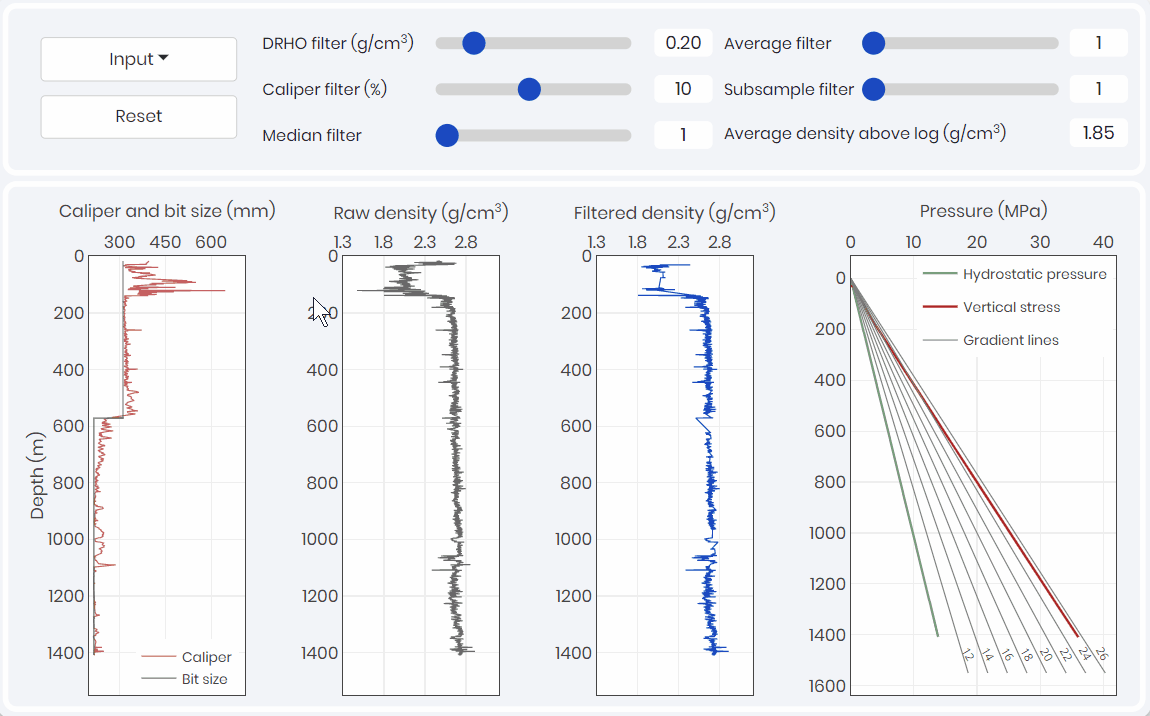Assuming that the overburden stress (Sv), is one of the three principal stresses, the stress tensor (representing the in-situ stress field) in the Earth’s crust can be explained by four independent components:
- Sv magnitude
- maximum horizontal stress (SHmax) magnitude
- minimum horizontal stress (Shmin) magnitude
- and the SHmax orientation
In the last two Geomechanics blog posts we covered how “Extended Leak-off Tests” can be used to estimate the minimum horizontal stress (Shmin) magnitude and how Geomechanics experts use “Image Logs” to determine the orientation of the maximum horizontal stress. In this post we explore calculating the 3rd element of vertical stress magnitude (Sv) using density logs and how different processing techniques can affect this estimation.
How do we estimate the vertical stress magnitude?
Precise knowledge of the vertical stress magnitude has become very important in drilling operations, particularly in deep water areas and in regions with high magnitude or shallow overpressures. The absolute vertical stress at a specified depth is defined as the pressure exerted by the weight of the overlying rocks and expressed as follow where ρ (z) is the density, z is depth and g is the acceleration due to gravity (~ 9.81 m/s2).

In offshore wells, the Sv is equal to the pressure exerted by the weight of the water column from the surface to the seabed plus the weight of the sediment column at a specified depth. Therefore, the Sv at any depth is easily calculated by integrating the density log from the surface (or seabed) where ρw is the density of seawater, at a water depth (Zw) and sb is the depth from seabed.

Seems straight forward however there are three issues that must be address before calculating the vertical stress.
3 issues that must be address before calculating vertical stress
1. The density log must be correctly formatted
- The depth scale on well logs is generally recorded relative to the distance along the hole below the rotary table. In deviated wells the ‘measured’ depth is greater than the true vertical depth below the surface. Hence, the calculated vertical stress is underestimated if the effect of wellbore deviation and the height of the rotary table above the surface are not taken into account.
2. The average density from the surface to the top of the density log must be estimated
- Geophysical logs are not usually available for whole well intervals to save on costs. Therefore, rock density needs to be predicted from the top of the well log to the surface.
3. The density log must be filtered to remove spurious data
- Different types of corrections, such as environmental corrections and data filtering, need to be applied on the raw density data to filter erroneous data since the density log, is highly prone to errors, particularly in washout or rugose zones where there is a poor contact between the pad of the density tool and the wellbore wall.
Here are some recommendations on how to remove unreliable data from density logs:
Use density log correction curve (DRHO) to isolate spurious density measurements. Density data was assumed to be inaccurate where the corresponding DRHO value is greater than 0.2 g/cm3.
The caliper log provides an alternative measure of borehole rugosity. If the caliper is greater than ±5% of the bit size, density data is assumed to be affected by the rugose hole, and should be removed.
A combination of filtering methods can be applied on the density logs to ‘de-spike’ and edit the density log (using a running median filter) and remove any anomalous measurements. Note that poor logging conditions are manifest as sharp low density spikes often associated with enlarged caliper readings.
Finally, the density logs need to be smoothed and re-sampled (e.g. using average and MOD functions) for filling gaps and a consistent calculation of vertical stress.

Above is a visualization of the Vertical Stress Calculator found in the metaKinetic platform where you can practice cleaning up the density log before calculating the vertical stress magnitude at any given depth.
Want access to this simulation and more on the metaKinetic platform? Contact us!
